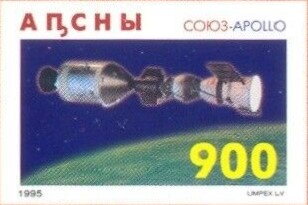Stamp: Soyuz-Apollo (Abkhazia 1995)
Soyuz-Apollo (Abkhazia 1995)
11 December (Abkhazia ) within release Space Project "Soyuz-Apollon", 20th Anniversary goes into circulation Stamp Soyuz-Apollo face value 900 Russian ruble
| Stamp Soyuz-Apollo in catalogues | |
|---|---|
| Michel: | Mi: AB 88B |
Stamp is horizontal format.
Issued in sheet of 12 stamps + 4 labels. Stamp number in Catalog of Republic of Abkhazia: 95 The "Soyuz-Apollo" space project was a joint mission between the Soviet Union and the United States in 1975. The mission involved the docking of a Soviet Soyuz spacecraft with an American Apollo spacecraft in Earth orbit, marking the first time that spacecraft from different countries had docked in space. The purpose of the mission was to test compatibility between the two spacecraft and to demonstrate the ability of the two countries to work together in space. The mission was a success and paved the way for future international cooperation in space exploration.Also in the issue Space Project "Soyuz-Apollon", 20th Anniversary:
- Full Pane - Soyuz-Apollo face value 12*900;
- Stamp - Soyuz-Apollo face value 900;
- Full Pane - Soyuz-Apollo face value 12*900;
- Souvenir Sheet - Soyuz-Apollo face value 900;
Stamp Soyuz-Apollo it reflects the thematic directions:
An anniversary is the date on which an event took place or an institution was founded in a previous year, and may also refer to the commemoration or celebration of that event. For example, the first event is the initial occurrence or, if planned, the inaugural of the event. One year later would be the first anniversary of that event. The word was first used for Catholic feasts to commemorate saints. Most countries celebrate national anniversaries, typically called national days. These could be the date of independence of the nation or the adoption of a new constitution or form of government. The important dates in a sitting monarch's reign may also be commemorated, an event often referred to as a "Jubilee".
Outer space (or simply space) is the expanse that exists beyond Earth's atmosphere and between celestial bodies. It contains ultra-low levels of particle densities, constituting a near-perfect vacuum of predominantly hydrogen and helium plasma, permeated by electromagnetic radiation, cosmic rays, neutrinos, magnetic fields and dust. The baseline temperature of outer space, as set by the background radiation from the Big Bang, is 2.7 kelvins (−270 °C; −455 °F)
A spacecraft is a vehicle that is designed to fly and operate in outer space. Spacecraft are used for a variety of purposes, including communications, Earth observation, meteorology, navigation, space colonization, planetary exploration, and transportation of humans and cargo. All spacecraft except single-stage-to-orbit vehicles cannot get into space on their own, and require a launch vehicle (carrier rocket).



